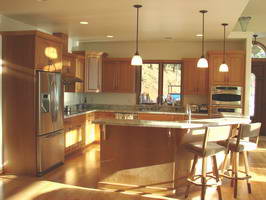Question – Cords and How to Identify the Individual Wires – Part 3
 '; ';
|
I think a hardware store employee gave me wrong advice about cords. One side is smooth, one is ridged; which is which? © By: Dave Rongey |
WELL,, you made my day for sure !!!! I really thought my mind and common sense had gone “out the window” when the salesman was telling me the way to connect the wires..
(Usually the wires from the fixture itself are separated, with one being black and one being white + the ground wire, making it simple to know which went where…. Wasn’t the case with this fixture,, and naturally I liked and wanted THIS one;Â (sounds like a woman, huh ?? )
I have done simple things (like replacing light fixtures, plugs etc) for years (just for family and close friends), and after listening to him, I REALLY doubted the way I had done it in the past!!! Needless to say, it really concerned me!! I am SO glad that I found your web site and got much needed answers with full explanations…. THANK YOU!!!
Now,,, what am I going to do?? Well,,, I can hardly wait until I get back to the store, find the salesman and confront him with (like you suggested),, “explain again to me about this wire”
AFTER that, I am not sure if I will strike him with the wire, or make a collar out of it for him!!
(Hope I don’t make the national news!!!! JUST KIDDING!! ) We DO need a little humor with all this, don’t we? Thanks again for all your help, and I will certainly keep your web site handy for any future questions!! You have been most helpful and greatly appreciated !
I have always gone by this little chart, that I keep in my tool box…(do you find it correct?)
ELECTRICAL NOTE:
Household wiring (or other AC applications in the 100+ volt range) use the following color codes:
BLACK “Hot” wire. Connected to Brass colored terminal. (and/or Side of cord that is smooth goes to brass screw)
RED ( Hot) “Traveler” wire. Used for 3-way switches.
GREEN “Ground” wire. Also called chassis ground.
WHITE “Neutral” wire. Connected to silver colored terminal. (and/or Side of cord that has grooves goes to silver screw)
Again,,, Thank you SO much for ALL your help !!!! (and I loved your humor,, I was thinking along the same lines as you suggested !)
[ad#block]Sorry for the delay – things got very busy around here.
Glad to hear you got a chuckle out if my late night humor, I like create smiles with others – makes life fun.
As for your Little Chart in your Tool Box, yes it is correct for some applications, however the RED can be used for other applications aside from 3-way switching, and I think I’d better make a web page about this because there are a lot of folks who are missing the other application. This has to do with wiring the circuits at the time of construction or remodel and can be used for 14-3 or 12-3 Romex, and is a common practice which saves money and time during the wiring process. In fact I am installing a few of these in a big remodel project right now. Instead of explaining it right now, and because photos will help explain, please hang in there for a few days until I get a chance to create the page for this. Actually this page will be one in a series of information having to do with circuits as they originate from the power source, typically the Main Panel or Sub-Panel.
It’s funny – I was explaining the last email we had to my wife and she got a kick out of it. I told her how sharp you were to ask for another opinion, then proceeded to show her what this was all about by looking at cords attached to appliances in our kitchen. Well – wouldn’t you know that we found a mixer that didn’t have ridges, but it had colors and the larger of two straight blades, and they actually connected the White wire to the Hot! I could not believe it – the factory or whoever made the molded cords and plugs made them all backwards! Well, I guess I’ll take it apart to see how they wired it inside the mixer and reverse it if I have to.
Along the same topic – a Contractor Journal just released a report having to do with a study by the government about the increase of electrocution incidences occurring with home appliances. I’ll dig deeper into this and bring this out on the web site as well.
I wish I could be there with you at the store when you approach the Salesman, you’ll have to let me know what happens if you get the chance.
Cords and How to Identify the Individual Wires – Part 1
Cords and How to Identify the Individual Wires – Part 2
The following may also be helpful for you:
|
|
Be Careful and Be Safe - Never Work on Energized Circuits!
Consult your Local Building Department about Permits and Inspections for all Electric Wiring Projects.
More articles about Identifying Wires Questions and Home Electrical Wiring: |
|
| « Previous | Next » |
Question – Home with Electrical Overload – Part 2 |
Question – Cords and How to Identify the Individual Wires – Part 2 |














